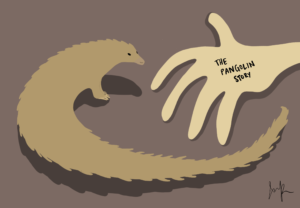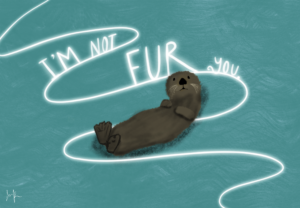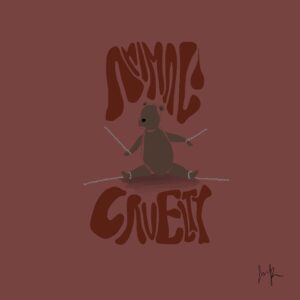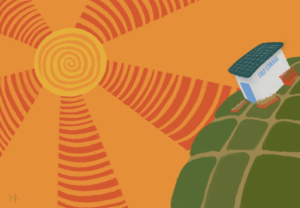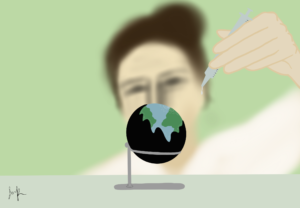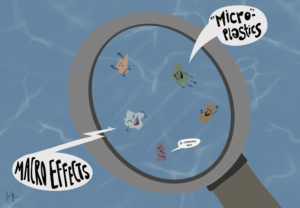By Jiaming Lou
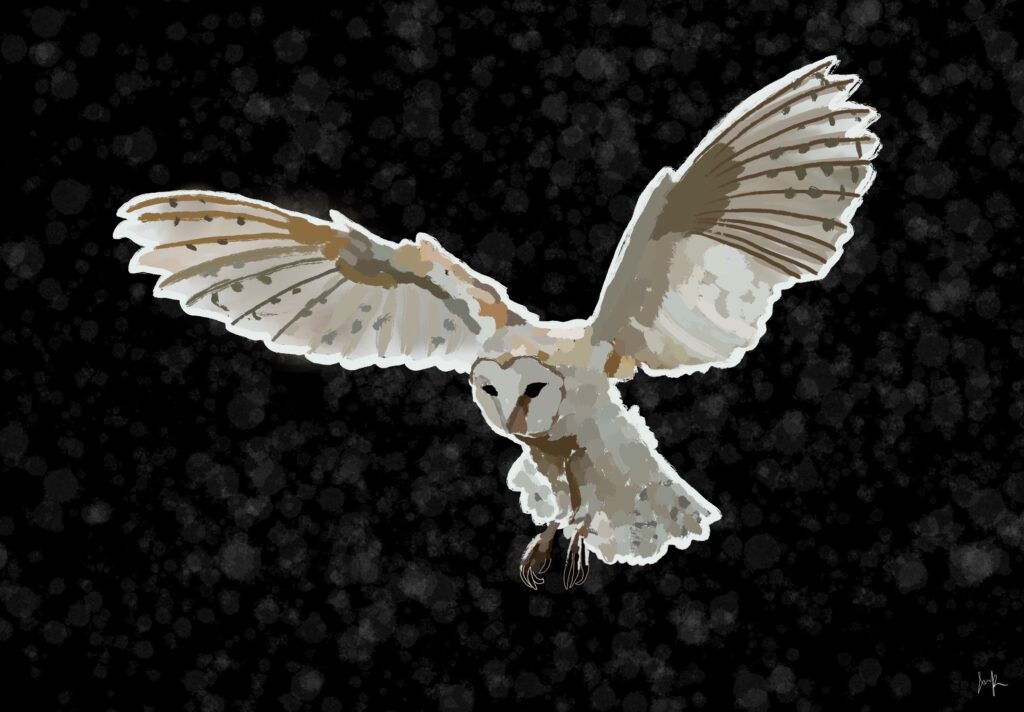
Four-year-old me would’ve likely said my favorite animal was a cat or dog because, one, I had no preference, and two, that’s just how limited my experience with animals was. Of course, eventually, I became exposed to many sorts of different animals, both through the screen and in real life. One day, I spied an owl perched on the branch of a tree outside my kitchen’s glass window. I got a second’s worth of a good look before it flew away, and I couldn’t tell you if it was a great gray owl, a barred owl, or a barn owl, but that was the moment for me. In that instant, I knew that I must learn more about them, and all the research was well worth it–owls have been my favorite animal, and for a good reason.
First, owls symbolize knowledge and wisdom. Greek mythology has it that Athena, the goddess of wisdom, had a reverence for owls; she chose the bird as her favorite companion, and eventually, the creature became her embodiment. Over time, myths were written down, and many books have continued to portray the owl as an image of intelligence. “In the Iliad, the owl is used as a successful disguise for Sleep when hiding from Zeus. In this scene, the owl symbolizes Sleep’s wisdom and intelligence” (Lee, “Why Are Owls Considered Wise?”). The Owl and the Grasshopper in Aesop’s Fable and The Silver Chair by C. S. Lewis are two more examples of literature containing the owl as a wise character. Being the bibliophile I am, I’ve also seen countless logos of the all-knowing cartoon owl in big, round glasses or stickers of the sage owl pointing at stacks of books with its wings. Owls and books have always inevitably been associated, and I am more than content to acknowledge this connection.
Second, night is arguably my most productive time of the day, and owls are known as nocturnal creatures, or creatures that rest during the day but are active at night to hunt. (There are some notable exceptions–such as the short-eared owl, which is diurnal, or active during daytime, and the Eurasian eagle-owl, which is crepuscular, or active during dusk and dawn only.) As raptors, or birds of prey, owls primarily target rodents and small rodent-like mammals. According to the Owl Research Institute, an owl’s diet may also include frogs, fish, lizards, snakes, squirrels, other birds, and occasionally even skunks! Unlike most owls, however, flammulated owls exclusively eat insects. Different owl species also have diverse hunting behaviors. For instance, while it is common for the barn owl to search for its prey during flight, the burrowing owl conventionally runs on the ground after its prey. Another technique is known as “perch and pounce,” where an owl perches in wait until it sees its prey, then glides down, or pounces, upon it. Generally speaking, owls hunt near ground-level–it gives them an easier time hearing or spotting their prey.
At the end of their hunt, owls return to their roost, or resting place. These roosts are frequently abandoned nests of other birds (such as hawks) or holes, called hollows, that naturally occur in trees or are created by woodpeckers. Other owls live up to their names by living in the spaces
they’re named for; the barn owl roosts in the rafters of barns and the burrowing owl rests in ready-made underground burrows. After mating, owl partners will defend and live in their roost area for several months.
But first they must mate, a process that usually happens in late winter. Males call through the chilling air and females listen for calls that interest them. By the way, not all owls make hooting noises; for example, the barred owl makes a sound more like a neigh than any vocalization close to a bird’s (Heimbuch, et al. “15 Amazing Owl Facts”). A female owl will only answer calls from a male owl of her same species. Once that interest is gained, males begin showing off (this can include fluffing his feathers or giving the female gifts of food). In the case of the short-eared owl, a male might perform a “sky dance”–one where he flies high above the female and claps his wings under his belly during a dive. He will then circle the female, fly up again, and hang in the air. After the performance, the male will dive past the female into the grass. If the female follows him, they may become a mating pair.
Owl partners spend a lot of time together. They engage in preening, an act of rubbing their beaks across each other’s heads and around the eyes. Scientists believe that preening not only maintains good feather condition, but also reduces fighting and other aggressive behavior (“About Owls”). And then they raise a family. The number of eggs a female lays varies from species to species, and also depends on the level of local food supply. Female owls are said to produce anywhere from one to fourteen eggs, however, if food supply is low, she might not lay any at all. Eggs are laid about one to four days apart, and only the mother sits on them to keep them warm. In doing so, she also loses her belly feathers in order to transfer more body heat to her eggs. While the mother is incubating, the father will hunt and bring back the food. The mother might tear the prey into smaller pieces to feed them to her babies.
Depending on the species, baby owls, or owlets, will hatch in three to five weeks. Owlets hatch in the order they were laid, and because they were laid on different days, this could result in different aged nestlings in the same nest. When young owls first hatch, their eyes are closed and their feathers are white. Several days after they’ve hatched, their eyes (which could be either black, brown, orange, or yellow) open, and their white feathers turn into darker brown or gray ones. Owlets grow quickly and can even swallow some prey whole within a few weeks. When they are first able to fly, the nestlings become fledglings. By autumn, most owl parents have finished raising their children–these fledglings have fully grown their adult feathers and are ready for life on their own.
Owls live all across the world (except for Antarctica) and range across 250 species. According to Defenders of Wildlife, owls’ habitats vary from the icy Arctic tundra to the arid Southwest Sonoran desert. Although owls’ living environments span to opposite ends of the climate spectrum, what they share is the threat of habitat destruction, change of land use, and currently ongoing population loss. Take the northern spotted owl, for illustration. They have been the most prominent species of the Pacific Northwest, and yet writer Kyla Mandel from National Geographic notes, “the owls’ numbers are the lowest on record—their population has declined by somewhere between 50 and 75 percent since 1995.” One of the primary reasons is that they’re being threatened by an invasive species, the barred owl. These birds are bigger and able to outcompete the native species for food and roosts. However, there have already been several solutions proposed, including a barred owl management program, which according to the US Fish and Wildlife Services (FWS), has been successful. Yet the northern spotted owl population still declines. Why? There must be a greater reason: habitat depletion. Old growth forests–which are the northern spotted owls’ only source of habitat–have declined by 70 percent over the last 30 years. This is in part due to natural wildfires, but also triggered by human activity. Whether that’s clearing land for more farming or exploiting resources to develop land, log, or mine for profit, it’s all destroying this owl species’–and many other animal species’ habitats, leading to the categorization of many vulnerable, threatened, and critically endangered creatures. And if we don’t take action soon, there’s no guarantee they can have a safe, protective future.
That being said, there is action we can still take. The first step is to be informed of such important issues–which you have taken, reader, just by getting to this point in the article. The second step is to take action, such as through spreading the news. As Denver Holt, the founder of the Owl Research Institute puts it, “public communication through many medias is the key…Whether we do it through, television, social media, and so forth, we need to engage with the public more.” Teachers, researchers, and knowledgeable individuals can all play a role. In the particular case of owls, it also helps to acknowledge World Owl Day. Perhaps you are able to donate to organizations that support the cause, or can reach out to those institutions about how you can help. This is as much a call to protect owls as it is a call to save the snow leopard, or Indus river dolphin, or the whooping crane, and all species at risk. When everyone does their part, we absolutely can restore the habitats that are crucial to so many creatures. And throughout the process, we are also preserving and protecting nature, our earth.
Works Cited
About Owls, Owl Research Institute, https://www.owlresearchinstitute.org/owls-1.
Heimbuch, Jaymi, and Martinko, Katherine. 15 Amazing Owl Facts, Treehugger, 8 June 2022, https://www.treehugger.com/owl-facts-that-will-amaze-you-4863920.
Lee, Charles. “Charles Lee.” Why Are Owls Considered Wise? (Here’s the Truth), BirdGap, https://birdgap.com/wise-owls/.
Mandel, Kyla. Despite Massive Effort, Spotted Owl Populations at an All-Time Low, National Geographic, 23 June 2021, https://www.nationalgeographic.com/animals/article/ northern-spotted-owl-populations-at-all-time-low.
Mastrorilli, Marco. State of the Owl, Owl Research Institute, 3 Aug. 2020, https://www.owlresearchinstitute.org/single-post/2020/08/03/state-of-the-owl.
Owls, Defenders of Wildlife, https://defenders.org/wildlife/owls.
The views and opinions expressed are those of the authors and do not necessarily reflect nor represent the Earth Chronicles and its editorial board.






